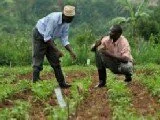An Ilorin-based industrialist and Chairman of Lubcon Group, Alhaji Jani Ibrahim, said mechanised farming is the way forward if the country is serious about revolutionising its agriculture.
Incontrovertibly, many experts believe that farming has gone beyond use of hoes and cutlasses which are the traditional implements used in clearing lands and cultivating crops of all kinds. With the advances made in technologies over the years, the business of farming has become simplified and made easier for farmers.
Ibrahim said: “We must revolutionise agriculture and it is not about hoes and cutlasses anymore. If we want to make a success of agriculture, we should learn to drive a tractor. It is a tractor that we need to help revolutionise agriculture.”
From production to processing and harvesting stages, appropriate mechanisation techniques could be adopted by farmers with the dual advantage of “reducing drudgery and increasing farm productivity”.
The federal government, through the National Centre for Agricultural Mechanisation (NCAM), a parastatal under the federal ministry of agriculture, has vigorously driven agricultural mechanisation with the development of simple, home-grown machines used for the production and processing of various crops.
The centre, established in 1990, was charged with the responsibility of developing and promoting agricultural mechanisation technologies for the transformation of Nigerian agriculture. It primarily engages in adaptive and innovative research towards the development of indigenous machines for farming and processing techniques.
Sited on 983 hectares of land along Ilorin-Lokoja Highway, the centre has over the years prided itself as a truly government-owned institution, driving the pace of agricultural mechanisation in Nigeria, having developed machines for easy planting, harvesting and process of various crops like rice, beans, cassava, maize, soya beans, among others.
Engineer (Dr.) Isaac Ozumba who heads the Agro-Industrial Development and Extension Department of the centre said: “Since inception, we have tested and certified over 60 tractors and implements. We have also developed machines for various crops. For cassava, for instance, we have developed full array of technologies from production to processing. We have the cassava planter. We have our first model which was developed, the second model and the third model that are in process now.
“We have the cassava harvester, both the manual and the tractor drawn. We have the cassava peeler. Cassava peeling has been a problem but we have been able to develop with 80 percent peeling efficiency. We have mechanical garri fryer, that is one of the latest technologies we have developed and we are now popularizing.”
Other machines developed at the centre include fish smoking kiln, Okro slicer, multi-crop thrasher used in processing various crops, cassava washing machine, cassava lifter, motorised cassava mash sifter, cassava grater and chipper, motorised rice thrasher, rice milling machine, seed expeller, groundnut decorticator, among others.
Daily Trust reports that while some of the machines were fabricated by engineers at the centre, others were done through adaptive research by bringing a technology from abroad and adapting it to the local environment.
The Executive Director of the Centre, Engineer Ike Azogu, explained that activities at the centre were targeted towards solving the value chain problems under the Agricultural Transformation Agenda (ATA) of the federal government.
He said: “ATA has specific crops like rice, soya bean, sorghum and we try as much as possible to develop technologies to be able to help in adding value to these crops and the Hon. Minister was here sometime last year to launch some of the technologies we have developed and commercialised.
“We have developed technologies for rice and most of the times, we don’t just develop these technologies, and we train people. For example, the rice thrasher that we developed, the federal government, under the ATA programme, brought in fabricators from seven West African countries for training on the fabrication of that machine. We have a fish smoking kiln for smoking fish. We also have orders for that which we have produced. We have developed soya beans thrasher.”
Engr. Ozumba, who took our correspondent round the centre, noted that in terms of affordability, the machines fabricated at the centre are cheaper than those made by individual fabricator, saying farmers could form themselves into cooperatives to acquire the equipment. He said the usefulness of the machines outweighs the cost, adding that Nigerian farmers are being conservative by wanting to stick to old traditional farming practices when there are technologies which would make their jobs easier.
He said: “We always advise farmers to go into cooperatives, into clusters to be able to buy these things. What the Nigerian farmer needs is to convince him that this thing is better. Our farmers are too conservative. For example, the first day I took a cassava planter to a community in Osun State, they felt it was not possible.
“We have a programme today called Cassava Mechanisation Programme, under the ATA, and the essence of that programme is to completely mechanise cassava production.
“As I am talking to you now, we are in averagely 20 locations, scattered all over the country, where we established cassava mechanisation farms, using full mechanisation technologies. I want to tell you that the average yield for a cassava farm is about 10 to 15 tonnes per hectare but with cassava mechanisation, we have been able to get 30 tonnes per hectare.”
However, the centre says its major constraint is in the area of funding in order to be able to acquire state-of-the-art equipment and computer aided machines to make its job easier. Currently, engineers at the centre fabricate with bare hands.
But the centre has the major challenge of publicising its innovations, given that most farmers lack knowledge of the centre’s existence, its activities and how they could benefit from the services offered by the centre to increase farm productive and solve the problem of food security.



No Comments